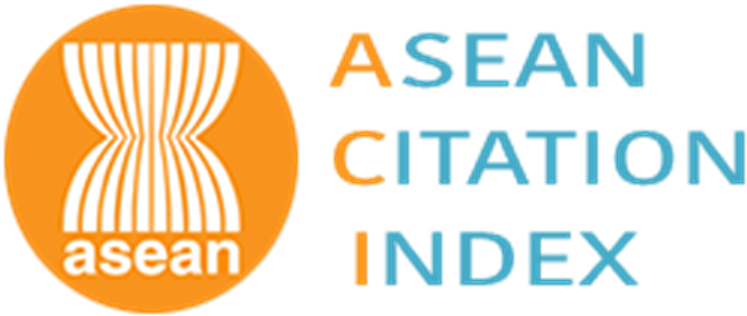Digital Mapping of Soil Salinization in the Dry Season Based on Sentinel-2 and Unmanned Aerial Vehicle images in Chatturat District, Chaiyaphum, Thailand
Abstract
เทคนิคการทำแผนที่ดิจิทัลดินได้นำมาใช้เพื่อประเมินการกระจายความเค็มของดิน วิธีนี้สามารถทำนายความเค็มของดินในพื้นที่ขนาดใหญ่ด้วยแบบจำลองค่าการนำไฟฟ้า และตัวแปรสิ่งแวดล้อม ซึ่งการวิจัยในครั้งนี้ใช้เทคนิค DSM สำหรับการจัดทำแผนที่ดิจิทัลความเค็มของดินในฤดูแล้ง พ.ศ. 2566 ในอำเภอจัตุรัส จังหวัดชัยภูมิ ด้วยภาพถ่ายจากดาวเทียม Sentinel-2 ภาพถ่ายจาก UAV และการวัดค่าการนำไฟฟ้า โดยสกัดปัจจัยตามหลัก SCORPAN และหลอมรวมจุดภาพด้วยการสอบเทียบดัชนี NDVI ด้วยสมการถดถอยเชิงเส้นตามลักษณะการใช้ประโยชน์ที่ดิน หลังจากนั้นจึงนำปัจจัยการเกิดความเค็มของดินที่ผ่านการสกัดทั้ง 23 ตัวแปร มาวิเคราะห์สหสัมพันธ์เพียร์สันและขจัดความซ้ำซ้อนของตัวแปร ทำให้ได้แบบจำลองถดถอยที่ประกอบด้วย 10 ตัวแปร ผลการวิจัยพบว่า แผนที่ดิจิทัลความเค็มของดินมีค่าการนำไฟฟ้า 0.06 ถึง 13.61 เดซิซีเมนต่อเมตร พบความเค็มในระดับเค็มเล็กน้อยมากที่สุดทั้งในพื้นที่ราบ และที่ราบลอนลาด คิดเป็นพื้นที่ 672.52 ตารางกิโลเมตร ซึ่งสอดคล้องกับรายงานการติดตามปัญหาความเค็มในแม่น้ำชีของกรมพัฒนาที่ดินและกรมควบคุมมลพิษ อีกทั้งแผนที่ดิจิทัลความเค็มของดินสามารถระบุค่าการนำไฟฟ้าและสถานะของความอุดมสมบูรณ์ของดินได้อีกด้วย ทั้งนี้หน่วยงานที่เกี่ยวข้องในการบริหารจัดการพื้นที่ศึกษาสามารถนำข้อมูลการกระจายตัวความเค็มของดินไปใช้ประโยชน์ ปรับปรุง ฟื้นฟู และติดตามความอุดมสมบูรณ์ของดินได้
Digital soil mapping techniques were used to assess soil salinity distribution. This method can predict soil salinity over large areas by modeling electrical conductivity and environmental variables. This research uses the DSM technique to digitally map soil salinity in the 2023 dry season in Chatturat District, Chaiyaphum Province, using Sentinel-2 satellite images, UAV images, and electrical conductivity measurements. In consistent with the SCORPAN principles, factors are extracted, and image points are fused with NDVI index calibration using linear regression equations based on land use characteristics. Then, the extracted soil salinity factors of 23 variables were analyzed by Pearson correlation, and the redundancy of variables was eliminated. The regression model consisted of 10 variables. The results show the digital map of soil salinity has an electrical conductivity of 0.0564 to 13.6099 decimeters per meter. The majority of flat regions and shallowly undulating plains (672.52 square kilometers) have slightly salinity levels. This is consistent with the report on monitoring the Chi River salinity problem by the Land Development Department and the Pollution Control Department. Digital soil salinity maps can indicate the electrical conductivity and state of soil fertility. The distribution of soil salinity can be used by the agencies in charge of managing the study area to monitor, restore and improve soil fertility.
Keywords
แผนที่ดิจิทัลดิน; ดินเค็ม; ภาพถ่ายจากดาวเทียม Sentinel-2; อากาศยานไร้คนขับ
Digital Soil Map; Soil Salinity; Sentinel-2; Unmanned Aerial Vehicle
[1] Department of Mineral Resources, “Saline soil area development in the northeast: Geological approaches Research Report,” Bangkok, Thailand, Department of Mineral Resources Conservation and Management. 2015 (in Thai).
[2] Land Development Department, “Impact of climate change on salt crust distribution in Lam Khan Chu Basin,” Soul Resources Survey and Research Division, Land Development Department, Bangkok, Thailand, 2011, pp. 10– 25 (in Thai).
[3] Pollution Control Department. (2022, May.). PCD to follow up on Chi River salinity problems. Pollution Control Department. Ministry of Natural Resources and Environment. Bangkok, Thailand [Online] (in Thai). Avalible: https://www.pcd.go.th/pcd_news
[4] Glossary of Soil Sciences Terms. SSS., United States of America, 2008, pp 88.
[5] Diagnosis and Improvement of Saline and Alkali Soils, Agriculture Handbook No.60, USDA., Washington, DC., 1954, pp. 160.
[6] Z. Zhang, B. Niu, X. Li, X. Kang, and Z. Hu, “Estimation and dynamic analysis of soil salinity based on UAV and Sentinel-2A multispectral imagery in the coastal area, China,” Land, vol. 11, no. 12, pp. 2307, 2022.
[7] J. Schulla, (2017, July). Model Description WaSiM (Water balance simulation model). Hydrology Software Consulting. Zurich, Switzerland. [Online]. Available: http://www.wasim.ch.
[8] Soil Surveys in Agricultural Development: Technical Bulletin No.14, LDD., Bangkok, 1972, pp. 3–7.
[9] Land Development Department, (2019, September). Map of land use conditions in Chaiyaphum Province 2019. Soul Resources Survey and Research Division, Land Development Department, Bangkok, Thailand [Online]. (in Thai) Avalible: http://www1.ldd.go. th/WEB_OLP/Lu_62/Lu62_NE/mapNE62/ CPM2562
[10] K. Jain and A. Pandey, “Calibration of satellite imagery with multispectral UAV imagery,” Journal of the Indian Society of Remote Sensing, vol. 49, no. 3, pp. 479-490, 2020.
[11] M. Sozzi, A. Kayad, F. Marinello, J. A. Taylor, and B. Tisseyre, “Comparing vineyard imagery acquired from Sentinel-2 and Unmanned Aerial Vehicle (UAV) platform,” OENO One, vol. 54, no. 2, pp. 189–197, 2020.
[12] Soil Survey Manual: USDA Handbook No.18, USDA., Washington, DC., 1993.
[13] L. J. Mangewa, P. A. Ndakidemi, R. D. Alward, H. K. Kija, J. K. Bukombe, E. R. Nasolwa, and L. K. Munishi, “Comparative assessment of UAV and Sentinel-2 NDVI and GNDVI for preliminary diagnosis of habitat conditions in Burunge wildlife management area, Tanzania,” Earth vol. 3, no. 3, pp. 769–787, 2022.
[14] T. Tajgardan, S.H. Ayubi, and F. Khormali, “Soil surface salinity prediction using ASTER data: Comparing statistical and geostatistical models,” Australian Journal of Basic and Applied Sciences, vol.4, no.3, pp. 457–467, 2010.
[15] A. Benslama, K. Khanchoul, F. Benbrahim, S. Boubehziz, F. Chikhi, and J. Navarro-Pedreño, “Monitoring the variations of soil salinity in a palm grove in Southern Algeria,” Sustainability, vol. 12, no. 15, pp. 6117, 2020.
[16] W. Wu, C. Zucca, A. S. Mhaimeed, W. M. Al-Shafie, A. M. Fadhil, V. Nangia, F. Zhu, and G. Liu, “Soil salinity prediction and mapping by machine learning regression in Central Mesopotamia, Iraq,” Land Degradation and Development, vol. 29, no. 11, pp. 4005–4014, 2018.
[17] R. Sluiter, “Interpolation methods in Interpolation methods for climate data literature review,” KNMI, R&D Information and Observation Technology, De Bilt, Netherlands, Intern rapport ; IR 2009-04, pp. 11-12, 2009.
[18] C. Ware, W. Knigh, and D. Wells, “Memory intensive statistical algorithms for multibeam bathymetric data,” Computers & Geosciences, vol. 17, no. 7, pp. 985–993, 1991.
[19] National Hydroinformatics Data Center, (2023, February). Daily weather monitoring, Bangkok. Thailand [Online] (in Thai). Avalible: https:// www.thaiwater.net/weather
[20] I. Suardi and D. Anggraina, “Comparison of NDVI, EVI, and SAVI methods to know vegetation density with Landsat 8 OIL images,” International Remote Sensing Applied Journal, vol. 2, no. 2, pp. 68–77, 2019.
[21] S. S. Shivangi and M. Kumari, “Comparative analysis of different vegetation indices with respect to atmospheric particulate pollution using sentinel data,” Applied Computing and Geosciences, vol. 7, pp. 100032, 2020.
[22] T. T. Zhang, S.L. Zeng, Y. Gao, Z. T. Ouyang, B. Li, C. M. Fang, and B. Zhao, “Using hyperspectral vegetation indices as a proxy to monitor soil salinity,” Ecological Indicators, vol. 11, no. 6, pp. 1552–1562, 2019.
[23] H. Zhang, L. Wang, L. Tian, and J. Yin, “A review of unmanned aerial vehicle low-altitude remote sensing (UAV-LARS) use in agricultural monitoring in China,” Remote Sens, vol. 13, no. 6, pp. 1221, 2021.
[24] S. Zhang and G. Zhao, “A harmonious satelliteunmanned aerial vehicle-ground measurement inversion method for monitoring salinity in coastal saline soil,” Remote Sens, vol. 11, no. 14, pp. 1700, 2019.
DOI: 10.14416/j.kmutnb.2024.03.004
ISSN: 2985-2145





